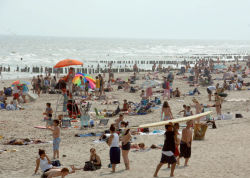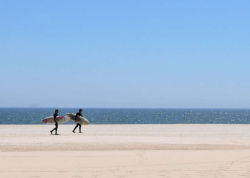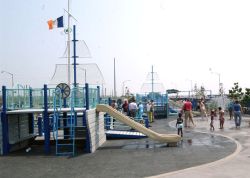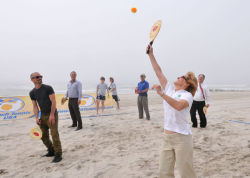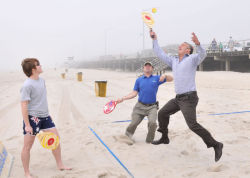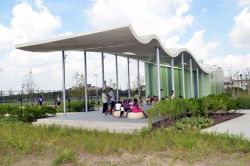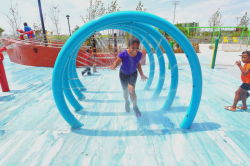Rockaway Beach and Boardwalk
Mayor Bloomberg And Secretary Jewell Announce Agreement On New Science And Resilience Institute As Part Of Cooperative Management Of 10,000 Acres Of City, Federal Parks In And Around Jamaica Bay
Monday, August 12, 2013
No. 274-13
http://www.nyc.gov/parks
CUNY Will Lead Intensive Research Program at New Institute; New Jamaica Bay–Rockaway Parks Conservancy Established
Mayor Michael R. Bloomberg and Secretary of the Interior Sally Jewell today announced progress on their cooperative management of 10,000 acres of federal and city-owned parks in and around Jamaica Bay – namely, the selection of a consortium led by the City University of New York to lead a new Science and Resilience Institute. The Institute will be a top-tier research center promoting an understanding of resilience in urban ecosystems and their adjacent communities through an intensive research program focused on the restoration of Jamaica Bay. They also announced progress on several other initiatives outlined under the management agreement, reached in July of 2012 between the National Park Service and the New York City Department of Parks & Recreation, including the formation of a Jamaica Bay-Rockaway Parks Conservancy. The Mayor and Secretary Jewell made the announcement at Riis Landing on the Rockaway Peninsula and were also joined by Housing and Urban Development Secretary Shaun Donovan, CUNY Acting Chancellor William Kelly and Peter Madonia, COO of the Rockefeller Foundation.
“Jamaica Bay is one of the greatest natural treasures any city has within its borders, and our Administration is working hard to make the bay an even greater, stronger, and more resilient natural resource for decades to come,” said Mayor Bloomberg. “The new consortium we’re announcing today is an all-star team of research institutions and non-profits who will do important work to protect and preserve urban ecosystems from development and from the effects of climate change.”
“In the City of New York, we have a powerful and dedicated partner to promote visitation, education programs, scientific research and opportunities for recreation in our urban parks,” said Jewell. “And now, in CUNY and their academic partners, we have a consortium of world-class institutions to advance our understanding of climate change and its impact on our natural systems. Working together, we will develop and coordinate approaches to coastal resiliency for Jamaica Bay that can serve as a model for communities around the world threatened by climate change.”
“Cutting-edge science is essential for understanding and managing the precious resources of the Jamaica Bay ecosystem and surrounding communities,” Director Jarvis said. “The Science and Resilience Institute at Jamaica Bay – with its stellar consortium of the region’s top-flight scientific institutions – will advance the role of science in managing resources and building regional resilience to future storms. And it is a model of how local scientific expertise can be marshaled to solve big problems, and to provide managers – like those of us in the National Park Service – with usable knowledge.”
“Since the signing of last year’s historic cooperative management agreement, NYC Parks has been proud to partner with the National Park Service to further our vision for a revitalized Jamaica Bay and Rockaway Parks,” said NYC Parks Commissioner Veronica M. White. “Even before Hurricane Sandy devastated our region, plans were in place to further resiliency efforts here at America’s great urban park. The new Science and Resilience Institute, with its CUNY-led consortium, will be a model for cutting-edge research. The creation of a beach grass nursery, establishment of a community partnership, presence of hard-working Jamaica Bay-Rockaway Parks Restoration Corps employees, and addition of new concessions, will not only help Jamaica Bay and Rockaway Parks recover from Sandy but also establish it as a premier destination for New Yorkers and visitors.”
“Today’s announcements are directly in line with several of the principles at the heart of the Task Force’s work, including the emphasis on resilience, the need for a regional approach to rebuilding and consistent engagement with academic, non-profit and philanthropic organizations,” said Secretary Donovan. “These innovative steps will serve as models for communities across the region and the country as they prepare for impacts of climate change and help them build in a way that makes them stronger, more economically competitive and better able to withstand future storms.”
“CUNY is proud to lead a consortium of world-class institutions in the new Science and Resilience Institute,” CUNY Interim Chancellor William P. Kelly said. “Together with our distinguished partners, we will engage in a groundbreaking effort to revitalize the Jamaica Bay ecosystem. This will include extensive research to enhance our understanding of the ecosystem and its resilience, and the coordination and implementation of a comprehensive revitalization and restoration program for Jamaica Bay and the entire watershed.”
“The Jamaica Bay Science and Resilience Institute will play a central role in advancing many of the 257 initiatives laid out in A Stronger, More Resilient New York, the City’s comprehensive climate change resiliency plan, which the Mayor released in June,” said Daniel Zarrilli, Director of Resiliency for the City of New York. “The City's resiliency plan was developed based on the best available scientific knowledge and research. I look forward to collaborating with both global and local experts as we build on that foundation of science to protect New Yorkers and make the City a more sustainable place to live.”
The new Science and Resilience Institute at Jamaica Bay establishes a top tier research center to promote the understanding of resilience in the urban ecosystem and adjacent communities. The Institute will develop a framework and programs in partnership with academic institutions, non-profits, the community and the many other entities and public agencies actively engaged in research in and around Jamaica Bay including NYC Parks, the National Park Service the New York City Department of Environmental Protection and the US Army Corps of Engineers. The consortium, which is under development and led by the City University of New York, includes many of the area’s most robust research universities as well as key local institutions: Columbia University’s Earth Institute and its Lamont-Doherty Earth Observatory, Cornell University, NASA Goddard Institute for Space Studies, New York Sea Grant, Institute of Marine and Coastal Sciences at Rutgers University, Stevens Institute of Technology, Stony Brook University, and the Wildlife Conservation Society.
To help realize the City and NPS’s vision for a revitalized, restored Jamaica Bay, the Institute will integrate cutting-edge research efforts from across the natural and social sciences; draw upon climate science, engineering, and sustainability and resilience studies to create a comprehensive program of research, monitoring and education; as well as outreach. The Institute, which will host visiting scientists, provide lab facilities for students and researchers and convene events to share and disseminate research findings, will be formally established by the fall of this year with a temporary space on the campus of Brooklyn College. The Institute’s first undertaking will be the ‘Urban Resilience in an Era of Climate Change: Global Input for Local Solutions’ Symposium October 17-18. The symposium will bring global and local expertise together to examine what urban resilience means and ways to achieve it.
The consortium was selected after a Request for Expressions of Interest was issued last year and respondents were evaluated with assistance from the Rockefeller Foundation. This collection of world-class institutions was selected based on the strong and collaborative framework provided in their proposal, the existing expertise of all partners on a variety of ecological and social issues faced by the Jamaica Bay ecosystem and surrounding communities, and the overall capacity of the consortium to successfully coordinate a comprehensive research program throughout the watershed. The proposal of the CUNY-led consortium included a number of details that aligned with the City and NPS vision for a revitalized, restored Jamaica Bay, including the integration of cutting-edge research efforts from across the natural and social sciences, drawing upon climate science, engineering, and sustainability and resilience studies to create a comprehensive program of research, monitoring, education, and outreach.
“Today is a historic day for New York City, as it stands poised to become a leading voice in the study and practice of urban resilience throughout the world,” said Peter Madonia, Chief Operating Officer, The Rockefeller Foundation. “While we can’t say when or where the next crisis will hit, whether it’s another superstorm on the east coast, or drought in Africa, we know it will come and that cities can mitigate the impact and enable a faster recovery from these events through increased resilience. The Rockefeller Foundation is dedicated to building resilience throughout the world so cities can not only survive major disruptions, but thrive. The Rockefeller Foundation is proud to have supported the creation of the Science and Resilience Institute in Jamaica Bay from its inception, and believe it will be a model for similar resilience centers around the world.”
Additionally, a public-private partnership has been established to raise funds for the planning and development of the Jamaica Bay-area parklands and waters. The new Jamaica Bay – Rockaway Parks Conservancy is chaired by longtime National Park Service philanthropist Tom Secunda, and its initial Board includes representatives from many of the City’s most respected not-for-profit organizations and institutions including Adrian Benepe of the Trust for Public Land.
Even as the City and NPS look to the future, the benefits of this partnership at Jamaica Bay and in the surrounding areas can already be seen. For example, this year the NYC Parks and the NPS together are fielding nearly 300 restoration corps members by combining resources and taking advantage of each agency’s hiring practices. The 200 members of the Jamaica Bay/Rockaway Parks Restoration Corps are complemented by approximately 100 recruits of the National Parks of New York Harbor Conservation and Resiliency Corps, managed by the Student Conservation Association. The combined restoration corps work throughout City and NPS properties helping the region recover from the effects of Hurricane Sandy by have restoring natural areas, planting Spartina grasses and removing debris. Additional benefits of the partnership are evident today in new resources and amenities for visitors such as food trucks, bicycling and boating rentals, and expanded public hiking and biking programs across the combined parklands. This successful first season will pave the way for additional ways to improve the visitor experience in the years to come.
The Mayor and Secretary also announced plans for a beach grass nursery at Floyd Bennett Field. This pilot program, with philanthropic support raised by the Jamaica Bay-Rockaway Parks Conservancy, will collect native seeds from Jamaica Bay and Rockaway and create a nursery to grow beach grass. The grass production would support efforts for coastline restoration in the region and citywide.
In June, Mayor Bloomberg announced “A Stronger, More Resilient New York,” our plan to rebuild communities and city infrastructure in a more resilient way in the face of threats from future storms. Fulfilling one of the goals in this plan, today kicking off phase two of beach and boardwalk restoration. Restoring parks and beaches is not only critical to resiliency but also part of our larger sustainability efforts citywide as part of PlanNYC.
Additional partnership opportunities for the national and city parks surrounding Jamaica Bay are expected to come out of the National Park Service’s new General Management Plan for Gateway National Recreation Area. The draft plan is available for public comment through Oct. 2, 2013, and a series of open houses are scheduled for those interested in learning more about the proposed alternatives. The public is invited to provide comments electronically at the NPS public comment website. Feedback from the public will inform the finalized General Management Plan that will be issued later this year.
- 30 -
Contact: Marc La Vorgna/Julie Wood (212) 788-2958
Arthur Pincus/Phil Abramson (NYC Parks) (212) 360-1311
Jessica Kershaw (DOI) (202) 208-6416
Mindi Rambo (National Park Service) (212) 668-2208
Check out your park's Vital Signs
Clean & Safe
$104.8M
Recent Investment
Green & Resilient
307
Mapped Trees
341.2
Acres of Natural Areas
Empowered & Engaged Users
Share your feedback or learn more about how this park is part of a
Vital Park System

